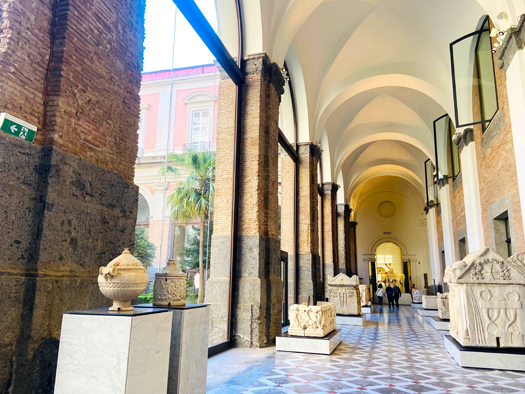
Earlier this year, I had the opportunity to vacation in Europe. An unexpected change in plans meant that I ended up “living” in Naples for a week and a half. Unbeknownst to me at the time, my short-term stay coincided with the Champions League football playoffs, which ended with the Società Sportiva Calcio Napoli (an Italian professional football club based in Naples) winning the playoffs and clinching the Serie A title; a first in 33 years! Needless to say, the city exploded with fans, loyal locals, and unsuspecting tourists (aka: me!) getting caught up in the days-long celebrations. Due to the sheer volume of people, public transit was limited and entire portions of the city were shut down to road traffic for several days.
Not to be hindered, I set out on foot to explore as much as I could of the area around my Airbnb on the outskirts of the city. Like the typical tourist, I was instantly enamoured with the obvious natural beauty and rich history of the popular tourist sites. But it was on my routine walks to the local grocer, bakery, pharmacy, and café when I began to truly notice and appreciate the resourcefulness and ingenuity of the local residents and business owners. Never before have I seen such great examples of using what you have, and adapting resources to fit changing business and cultural needs. If you’ve ever been to the city, and especially in the suburban areas, you’ll often feel like you’re stepping back in time because, well…you are. The old cobblestone streets have become main roads, decades- and centuries-old houses and apartment buildings are still fully inhabited, areas so densely populated and buildings built so closely together that it’d be near impossible to redevelop land to build something more modern. Yet, this has not hindered progress and the availability of modern amenities.
By the end of my trip, the commercial real estate side of my brain was swirling with ideas and a better appreciation of the concept of adaptive reuse. That is, by definition, reusing an existing building for a purpose other than for which it was originally built or designed. (As an aside, one of my favourite examples of adaptive reuse was the building housing the Naples National Archeological Museum; I highly recommend visiting, if you get the chance.)
In the months since I’ve been home and back to “real life”, I have noticed and appreciated more examples of adaptive reuse here. Specifically in Halifax, there are several local developers who have started to incorporate elements of this architectural concept into their projects in a more visible way.
Atlantic Canada, with our rich history and stunning landscapes, possesses a wealth of potential for more adaptive reuse in commercial real estate. As the region seeks to revitalise urban centers and historic areas, there is much we can learn from Europe, where adaptive reuse has long been a successful and transformative trend. In the next few paragraphs, I will explore some ways I believe Atlantic Canada can- and should- draw inspiration and insights from European adaptive reuse practices to shape our own commercial real estate landscape.
Preservation of Heritage: Europe has a deep commitment to preserving its historical architecture. Atlantic Canada, with our own unique heritage, can learn the value of preserving historic structures when at all possible. Europe demonstrates that adaptive reuse not only safeguards historical landmarks but also attracts tourists and stimulates economic growth. As has already been done in some areas, Atlantic Canada’s historic buildings can be repurposed as boutique hotels, museums, or cultural centers to further promote tourism and celebrate our rich history.
Mixed-Use Developments: European cities excel in creating mixed-use spaces that combine residential, commercial, and recreational areas within the same building or district. In an earlier blog post, I wrote about the opportunities Atlantic Canada has to embrace this trend to maximise efficiency for owners and tenants, address urban sprawl, reduce commuting, and foster vibrant communities. By converting old warehouses and factories into mixed-use spaces, we can create vibrant neighborhoods where people live, work, and play.
Sustainability and Green Initiatives: Europe leads the way in sustainable building practices. Atlantic Canada can adopt these practices to reduce environmental impact and lower operating costs. Incorporating energy-efficient designs, renewable energy sources, and green building materials into adaptive reuse projects can align with the region’s commitment to environmental preservation and attract eco-conscious tenants and investors.
Cultural Transformation: European cities have successfully turned former industrial areas and disused structures into cultural hubs, art galleries, and event spaces. Atlantic Canada can follow suit, revitalising its industrial waterfronts into bustling cultural centres; transforming and invigorating local arts scenes, promoting community engagement, and boosting tourism.
Innovation and Technology Centers: Many European cities have repurposed old industrial sites into thriving innovation and technology hubs. With Atlantic Canada’s growing tech sector, we can continue to take inspiration from Europe’s successes. Converting old industrial, commercial, or office spaces into collaborative workspaces, incubators, and tech hubs; fostering entrepreneurship and innovation in the region.
Community Involvement: European cities often involve the community in decision-making processes for adaptive reuse projects. This fosters a sense of ownership and ensures the projects align with local needs and values. Atlantic Canada can engage its communities in similar ways to create projects that resonate with its residents.
Atlantic Canada stands at a pivotal moment in its urban development journey. While the new modern commercial developments provide great value in their own rite, it can sometimes be hard to see the big picture as well as the opportunity to capture history and bring it into the present. While we may not have the centuries-old architectural history Europe does (and will face our own set of challenges and costs to face when undertaking local projects), we can still draw inspiration from their adaptive reuse trends in commercial real estate. We can find our own ways to further capitalise on our unique history and natural beauty to revitalise our urban centers, promote sustainability, and foster economic growth. As Atlantic Canada embraces these lessons from across the Atlantic, we have the potential to create vibrant, innovative, and sustainable communities that thrive for generations to come. The future of Atlantic Canada’s commercial real estate landscape is rich with opportunities, waiting to be unlocked through the lessons learned from successful adaptive reuse practices around the world.

Emily McClelland is a Consultant in our Brokerage Division and has experience in handling a variety of leasing and sales transactions in Nova Scotia. For commercial real estate brokerage advice, you can reach her at or by phone at 902-429-1811.
